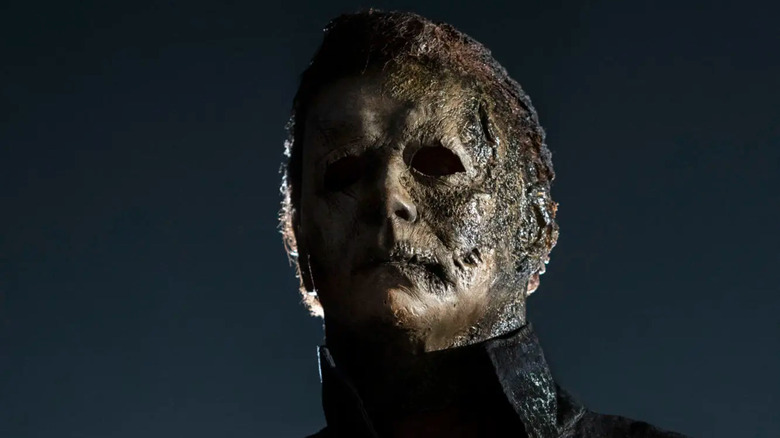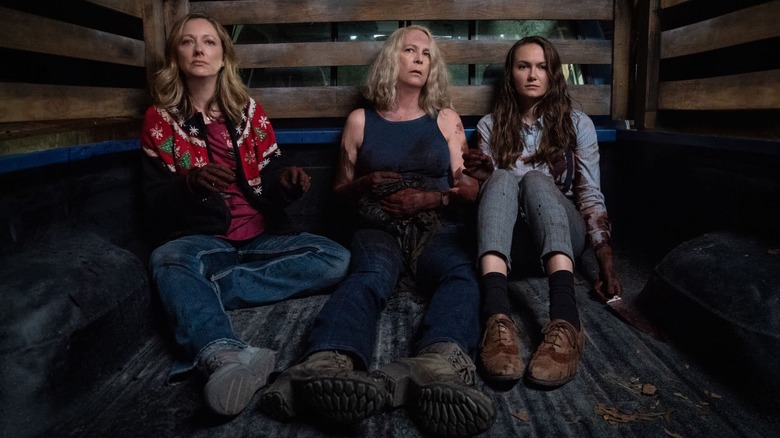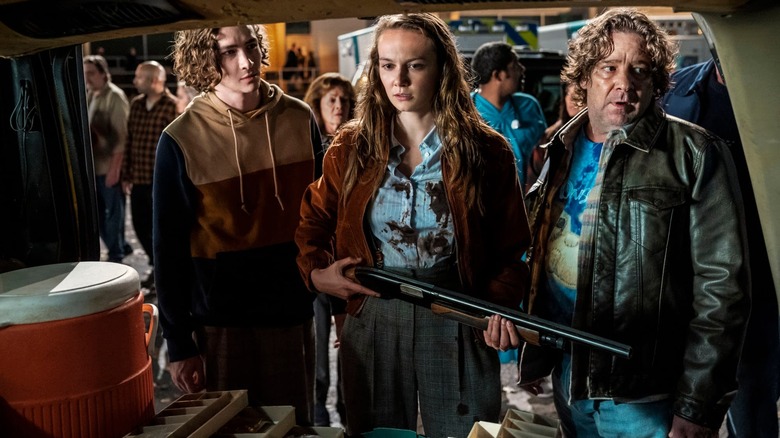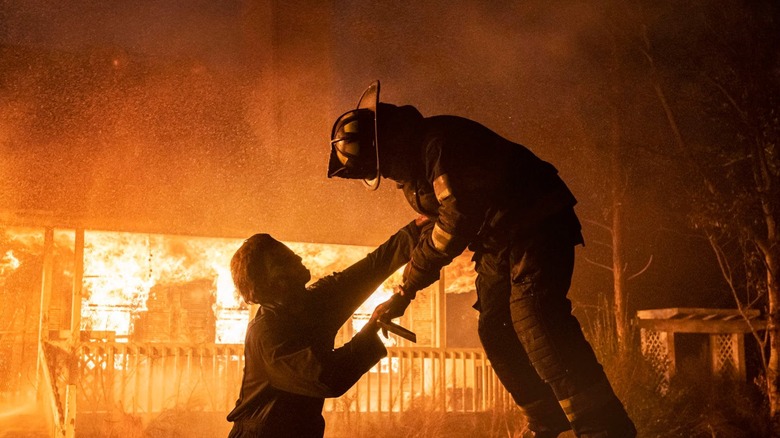Halloween Kills Spoiler Review: A Messy, Bloody Sequel That Can't Make Up Its Mind
When the reboot/revival/sequel "Halloween" arrived in 2018, trauma was a major talking point. This wasn't just another slasher movie, we were told. This was really a movie about trauma, and how it can reverberate through time. It was also a movie about how Laurie Strode, a traumatized woman who has been living in the shadow of Michael Myers for her entire life, was finally going to take back her own narrative. That's inspiring stuff, and for the most part, "Halloween" delivered. Director David Gordon Green took the unique approach of ignoring virtually every "Halloween" sequel after John Carpenter's original. The stuff about Laurie being Michael's long-lost sister? It never happened. Neither did any of the other things in the many sequels. For the sake of this timeline, Michael Myers killed his sister in 1963 and was sent to an asylum. In 1978, he busted out of that asylum and headed home to Haddonfield where he promptly stalked and murdered a group of babysitters. One of his potential victims, Laurie Strode (Jamie Lee Curtis), got away – only to spend the rest of her life terrified that Michael, aka The Shape, would come calling again.
As it turned out, Laurie was right to be paranoid. In 2018, Michael escaped yet again, and once again turned Haddonfield into a slaughtering ground. But Laurie wasn't going to be caught unaware this time. Instead, working with her daughter Karen (Judy Greer) and granddaughter Allyson (Andi Matichak), Laurie trapped Michael in her house and burned the joint down. The film ended with the assumption that Michael Myers had finally been defeated, and Laurie Strode could finally find closure.
But there can be no real closure when box office dollars are on the line. And after the 2018 "Halloween" made a killing at the box office, it was only a matter of time before a sequel would follow. And while "Halloween" wasn't exactly subtle about leaning into the trauma angle, "Halloween Kills" practically bludgeons us with it, to the point where it feels like Laurie Strode is about to turn directly to the camera and say, "Folks, this movie is about trauma."
But "Halloween Kills" is the first of two sequels that were announced with the goal of creating a brand-new trilogy with a brand-new timeline. And while a trilogy might finally allow Laurie to have some sort of closure, it also results in an oddly incomplete sequel. "Halloween Kills" perhaps wants to be the "Empire Strikes Back" of this trilogy; the darker middle entry that keeps things open-ended for the big, dramatic conclusion. That's fine, in theory. But "Halloween Kills" feels incredibly rushed, and strangely empty. A lot happens in this movie, and yet, it feels like nothing has been accomplished. The story hasn't moved forward. Ultimately, "Halloween Kills" feels less like a movie and more like a bonus feature; a fill-in-the-blank story that shows exactly what happened a few minutes after the previous movie ended and not much else. Ultimately, "Halloween Kills" does little more than increase Michael's body count.
Why Does Laurie Strode Spend Almost The Entire Movie In Bed?
But none of that is to say "Halloween Kills" is a complete bust. It's by no means the worst "Halloween" sequel – how could it be, when "Halloween Resurrection" exists? But "Halloween Kills" is also a film that wants to have its Halloween candy and eat it, too. Trying to perhaps give us the best of both worlds, "Halloween Kills" wants to be the thinking person's slasher film, full of weighty, timely themes. But it also wants to satiate gore-hounds by ramping up the brutality. This leads to a rather repetitive experience where "Halloween Kills" introduces us to a new group of characters, has them deliver clunky, on-the-nose dialogue, and then makes us watch them be graphically murdered. Not helping matters is the fact that "Halloween Kills" sidelines Laurie, having her spend the entire film in the hospital.
Could this be Green and co-writers Scott Teems and Danny McBride paying tribute to the original "Halloween II," in which Laurie also spent the entire runtime convalescing from her wounds? Perhaps, but that doesn't mean it's a good idea. The entire selling point of this new series is the return of Jamie Lee Curtis as Laurie Strode. Why, then, is she forced to spend nearly this entire movie in bed? This choice might be forgivable if "Halloween Kills" had shifted its attention to Laurie's immediate family, her daughter Karen and granddaughter Allyson. But the surviving Strode ladies also get sidelined here. Karen spends the bulk of her screentime hanging out in the hospital with Laurie, while Allyson joins a vigilante group but doesn't get much of anything to do until the film's final moments.
Instead, "Halloween Kills" devotes most of its time to the residents of Haddonfield, most of whom will be dead by the time the movie ends. This isn't a terrible idea, in theory. But the results are lackluster. After a pattern of slaughter emerges, it becomes difficult to give a damn about any of these people. Why should we get attached when we know every newly introduced character here is being headed to slaughter? If "Halloween Kills" made an attempt to make us care about these individuals, their brutal demises might carry some weight. But these people are strangers to us.
Green and company clearly try to subvert this problem by bringing back characters from John Carpenter's original, and going so far as to even bring back some of the actors who played these same roles over 40 years ago. Kyle Richards returns as Lindsey Wallace, one of the children being babysat in the 1978 film. Nancy Stephens is back as Marion Chambers, a nurse who was briefly seen working with Michael's doctor/mortal enemy, Dr. Loomis. And Charles Cyphers returns as Leigh Brackett, the former sheriff of Haddonfield who lost a daughter to Michael Myers in 1978 (he works as a security guard at the hospital now). Then there's Robert Longstreet as Lonnie, a character who was briefly seen in the 1978 film and who was casually mentioned in the 2018 "Halloween." And there's Anthony Michael Hall taking on the role of Tommy Doyle, the kid Laurie was babysitting in the John Carpenter film.
But bringing these characters back amounts to very little. Sure, we met these characters once before – but they were completely different people then. Bringing back some of the original actors does very little to make these people seem familiar. And it feels particularly wasteful when Green has almost all of them bumped off. There's a certain cosmic cruelty here – the idea that while some of these people escaped Michael Myers over 40 years ago, he still managed to catch up and kill them in the end. But "Halloween Kills" doesn't really know how to capitalize on this tragic irony. It simply kills people off and quickly moves on to the next kill.
I Don't Think About You At All
Before "Halloween Kills" picks up immediately where the last film left off, it also takes us back in time to show how Michael Myers ended up getting caught in 1978. This allows Green to have fun recreating (or trying to recreate, at least) John Carpenter's aesthetic. But it also feels like little more than showing-off; going back to '78 to show us something we could've figured out on our own – Michael was captured after being shot multiple times by Dr. Loomis, great, got it – almost immediately robs the movie of forward momentum. The point of the flashback is to provide a character arc for Frank Hawkins (Will Patton), a local cop who feels guilty for not letting Michael Myers die back in 1978. As we learn, Dr. Loomis – played here by the film's art director, Tom Jones, Jr., not by a digital recreation as I've seen some people claim – wanted to flat-out execute Michael after he was apprehended, but Hawkins stopped this because he thought it was wrong. Again: a neat idea! And it results in a moment where Laurie, the tormented woman, forgives Frank, thus alleviating some of his guilt. But this ultimately feels hollow.
Having Laurie forgive Frank also conflicts with one of the movie's more intriguing ideas: that none of this is about Laurie Strode. Of course, this idea immediately conflicts with the idea put forth in the 2018 "Halloween," which means all of his congeals to give one the impression that no one working on these films has any sort of plan. They're just winging it as they went along, similar to the recent "Star Wars" Trilogy. And we all know how that worked out in the end ... (not well).
In the original "Halloween" series, Michael's targeting of Laurie made sense – sort of – because it was revealed that she was his sister. But Michael and Laurie are not related in this current timeline, and "Halloween Kills" dares to suggest that maybe, just maybe, Laurie doesn't really matter to Michael all that much. That might throw some fans of the franchise off, but I found it to be an interesting idea. After setting Michael on fire and believing him dead, Laurie ends up in the hospital, recovering from her wounds. Karen and Allyson go with her, and at first, Karen operates under the assumption that Michael deliberately targeted Laurie this time.
But the audience – and Allyson and Frank – knows differently. Because Michael wasn't directly coming for Laurie in 2018 – he only ended up at her house because his doctor, the insane Dr. Ranbir Sartain, brought him there. Karen and Laurie think this was all fate; that Michael has been gunning for Laurie all these years. With that in mind, they assume Michae will come directly to the hospital to get the job done. But Allyson knows that's not the case, and heads out with a mob of Haddonfielders to track Michael down. And Frank, recovering from his wounds in the hospital bed right next to Laurie, fills the once and future final girl in on the truth: that none of this is about her, and it never was.
Curtis, who does the best she can with such a limited role, plays this moment perfectly. She makes Laurie look downright crestfallen at this realization. Laurie has spent her entire life believing that she and Michael Myers are entwined. It's the one thought that's peppered her entire life, and turned her into an emotional wreck. And she's been wrong this entire time. It's like that moment in "Mad Men," where copywriter Michael Ginsberg tells Don Draper that he feels sorry for him, only for Don to shoot back: "I don't think about you at all." (Yes, I am comparing Michael Myers to Don Draper here, just go with it.) But before we can really linger on this realization, "Halloween Kills" has moved on to its next burst of ultra-violence. "Maybe they'll address this more in the next movie?" you might think. But you know what would've been cool? If they had addressed it more in this movie instead.
Evil Dies Tonight
I'll say this much for "Halloween Kills" – it delivers on its title. There are kills aplenty here, and watching the Shape lay waste to Haddonfield is satisfying in its own ways. But after a while, this, too, feels like it was poorly thought out. Michael was brutal in 2018's "Halloween," but the brutality made a certain sense from a storytelling perspective. This was meant to be the big return of Michael Myers, and what way to make him seem scary again than by turning him into an unstoppable killing machine who rips people's teeth out of their heads? As violent as Michael seemed in the previous film, it was more or less in line with the character's previous outings. But the Michael in "Halloween Kills" is downright sadistic, and this feels like a miscalculation to me. I can buy into Michael as something akin to the shark in "Jaws," or the Terminator in the original "Terminator." That is, I can buy him as a kind of weapon of mass destruction that cuts through people indiscriminately. If you're in his path, he's going to destroy you in order to keep on moving.
But the Michael in "Halloween Kills" appears to be deriding a kind of sick glee from his actions. He doesn't just kill people, he flat-out tortures them, as he does during a moment where he jams a fluorescent light into a woman's neck and then makes her watch as he stabs an entire knife-block of knives into her husband's back, one after another. Why? Why is Michael suddenly taking things to this whole other level? Laurie has a theory late in the film that the more Michael kills, the more powerful – and unstoppable – he becomes. Again: a neat idea. But, like pretty much everything else in the movie, it comes across as an afterthought; an undercooked concept that may or may not be addressed in the third film.
You get the sense that Green and company are going for something nihilistic here; a dark, cruel movie to reflect our dark, cruel times. But you also get the sense that they're having too much fun to really commit to that. The idea of a mob getting out of control is something the "Halloween" franchise has explored before, and fleshing that out a bit more here starts off as a good concept. But by the time things have gone horribly wrong, and Brackett is delivering lines like "Now he's turning us into monsters!" it all grows so painfully on the nose that you start to mentally check out. Still, there are glimmers here of a smarter movie. I absolutely can believe that residents of a small town would spend almost their entire lives remembering one night. And I quite like Anthony Michael Hall's work as Tommy, playing him as a dumb lunk who thinks he's the hero of this story, only to quickly learn he's in way over his head. And I can certainly appreciate one of the film's climactic moments where Michael, having been beaten down by the mob, rises up and murders pretty much everyone he can see. But these are the fleeting, final moments in an otherwise poorly planned story.
How will it all end with "Halloween Ends"? Will the third entry close the loop in such a way that we look back at "Halloween Kills" with renewed understanding? I'd like to think so, but I have my doubts. I quite enjoyed "Halloween" 2018 despite its flaws, but, while I can appreciate a lot of what's going on in "Halloween Kills," the flaws have multiplied to the point where they've become harder to overlook. After making such a point of claiming that none of this is about Laurie Strode, Green and company immediately change that by having Michael (seemingly) murder Karen, Laurie's daughter, thus ensuring that this is all about Laurie again. "Halloween Kills" wants to have it both ways; it wants to be both trick and treat. And you get the distinct impression that the filmmakers are hoping we're too dumb to catch on.



